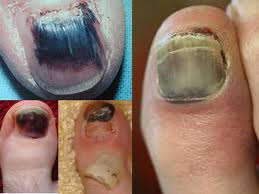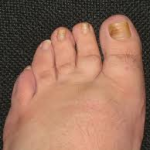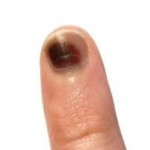A discolored toenail usually means that something is wrong, and unless you have another obvious explanation, you should consider the possibility that you have a fungal nail infection. Other possible explanations would include a recent blow to the tip of the toe, causing bleeding and blackening under the nail, bacterial growth beneath the nail (often a green color), continuous use of nail polish on the nail, or some other uncommon medical condition. The problem, however, is usually fungus.
Fungal infection
 Fungi are capable of producing many colors, and the species that invade nails and cause a discolored toenail are no exception. In laboratory culture, the so-called dermatophytes are predominantly yellow, mahogany brown, or reddish, while saprophytic fungi that invade nails are often green, black or brown, or colorless. Though these fungi may not exhibit exactly the same characteristics when growing on a nail, they do often produce a yellow, brown or even black color. It generally starts out as a slight yellowish tinge to the nail, or even a white spot, but color develops more fully as the fungus begins to spread and mature.
Fungi are capable of producing many colors, and the species that invade nails and cause a discolored toenail are no exception. In laboratory culture, the so-called dermatophytes are predominantly yellow, mahogany brown, or reddish, while saprophytic fungi that invade nails are often green, black or brown, or colorless. Though these fungi may not exhibit exactly the same characteristics when growing on a nail, they do often produce a yellow, brown or even black color. It generally starts out as a slight yellowish tinge to the nail, or even a white spot, but color develops more fully as the fungus begins to spread and mature.
In an advanced fungal nail infection, a discolored toenail is a minor symptom compared to the thick flaky distorted appearance of the nail and the discomfort of fungal spread to the skin of the toes. Once a nail infection has gone this far, it will be difficult to treat, and even with proper treatment it will probably take a long time to clear up. If you notice a discolored toenail, it’s best to take care of it right away. See your doctor to confirm that treatment for fungus is a sensible approach, and begin treatment immediately.
A fungal nail infection is easier to treat in its early stages. In lieu of expensive prescription drugs, many people choose a natural topical remedy. Some of the best contain tea tree oil, an essential oil of the tea tree that has been shown to have antifungal properties. Other natural remedies include an oral herbal treatment to aid the topical preparation, and there are many folk remedies for the condition as well.
The biggest challenge for any topical preparation is penetration of the nail so that the treatment can contact, and kill, the fungus. A thin discolored toenail in the early stages of infection will be more easily penetrated than a thick distorted toenail with advanced fungal growth – so treat your fungal nail infection now, before it gets worse.
Aging
 Changes in the rate of nail growth can cause thickening. Slow nail-growth can be caused by factors such as age, disease or diet. An increase in nail production can be caused by pressure, such as when the ends of your toes rub against your shoes. The yellowish appearance is a result of the nail losing its translucency as it thickens.
Changes in the rate of nail growth can cause thickening. Slow nail-growth can be caused by factors such as age, disease or diet. An increase in nail production can be caused by pressure, such as when the ends of your toes rub against your shoes. The yellowish appearance is a result of the nail losing its translucency as it thickens.
Medical condition
Chronic medical conditions also can affect the appearance of the nails. Specific color changes in the nails can be suggestive of diabetes or of liver, kidney, heart, or lung conditions. This is why doctors pay specific attention to nails during a routine physical examination.
Other, rare causes of discolored nails include the “yellow nail syndrome,” an inherited condition that results in slow-growing, discolored nails and is associated with lymphedema (swelling of tissues due to the accumulation of fluid) and lung diseases. Nails may also appear lightened to a whitish-yellow color if there has been separation of the nail from the nail bed, termed onycholysis.
Injury
Injury to the nail may cause discoloration. Mild trauma to the nail can cause white spots to form on the nail, says the American Academy of Dermatology. These white spots usually grow out with the nail and are not serious. If many white spots appear with no clear cause, a medical examination may be needed, as this may signal infection. The American Academy of Dermatology also describes a splinter hemorrhage. This occurs when the nail has sustained an injury that causes a reddish brown line under the nail where the blood vessels have been damaged. Some medical conditions may also cause these hemorrhages, so a dermatologist should examine any nails with this condition.
Medications
 The Merck Manual states that some medications cause nail discoloration; this typically resolves once the medication is stopped and the nail grows out. Drugs that may alter nail color include chemotherapy drugs, such as bleomycin; antibiotics, such as minocycline; arsenic poisoning; silver, from occupational absorption or supplements; and the drug AZT for treatment of human immunodeficiency virus. Effects on nails include a bluish-black color, white bands, brown tints and gray coloration.
The Merck Manual states that some medications cause nail discoloration; this typically resolves once the medication is stopped and the nail grows out. Drugs that may alter nail color include chemotherapy drugs, such as bleomycin; antibiotics, such as minocycline; arsenic poisoning; silver, from occupational absorption or supplements; and the drug AZT for treatment of human immunodeficiency virus. Effects on nails include a bluish-black color, white bands, brown tints and gray coloration.Prevention
- Wearing shoes that fit properly and allow you to wiggle your toes can help your toenails from thickening as a result of pressure.
- Avoiding nail polish that is dark in colour and applying a base coat to your nails can reduce staining of the nails.